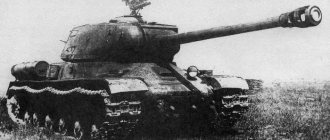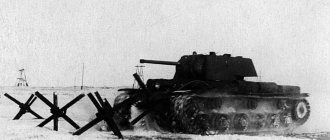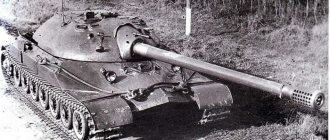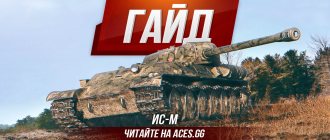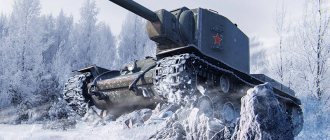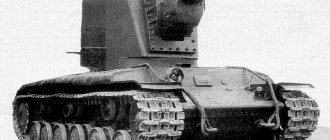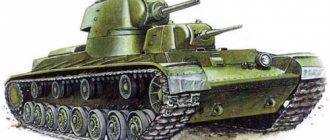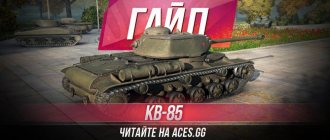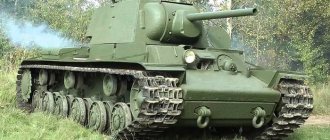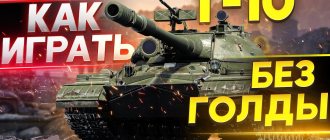The IS-2 heavy tank is one of the most famous and successful examples of USSR armored vehicles during the war period. This tank, which passed through all the hardships of the final stage of the Great Patriotic War with honor, at that time surpassed all analogues in some qualities, and later became the ancestor of post-war Soviet heavy tanks.
It is noteworthy that, unlike most tanks created in the middle of the war, the IS-2 remained in service for many years, outlasting even the more modern vehicles that were supposed to replace it.
History of the creation of the tank
At the beginning of 1942, the designers of the Chelyabinsk plant tried to implement the idea of a tank that would match heavy tanks in terms of firepower and armor protection, and medium tanks in size and mobility. They tried to achieve this by reducing useless internal volumes and compacting the layout. The experimental KV-13 was going to be armed with a 76mm cannon. A sample with a 122mm howitzer was also produced.
After the appearance of the German Tiger tanks on the battlefield, the pace of development was accelerated and in the winter of 1943 both versions of the KV-13, renamed IS (Joseph Stalin), were requested for state testing. The IS was recognized as promising, but it was not destined to become the first main battle tank. Tests of captured "Tigers" revealed that the 85mm cannon can fight it most effectively.
In order to place such a weapon in a tank without worsening the working conditions of the crew, the length of the hull and turret ring had to be increased. The IS has become larger, heavier, and slower. In the fall of 1943, the vehicle was decided to be put into service, but even earlier, plant director Joseph Kotin proposed the idea of installing an A-19 122mm cannon on the IS, pointing out the effectiveness of its use against the Tigers.
A tank with enhanced armament, called the IS-2, was produced for two months in parallel with the IS-1 (with an 85mm cannon).
In February 1944, assembly of the original version was stopped, and only the IS-2 remained on the assembly line.
Design
The crew of the IS-2 tank was located like this: the driver sat in the bow, between two fuel tanks. At his disposal were an inspection hatch and two prismatic periscopes in the roof. Later, the hatch was replaced with a triplex glass block.
There was an evacuation hatch at the bottom of the hull behind the driver's seat. The turret contained seats for the gunner and commander (on the left side) and the loader (on the starboard side). The commander monitored the situation using six viewing slits in the commander's cupola, and the loader used the MK-IV periscope for observation.
The armor hull of the IS-2 was welded from cast and rolled armor. On early cars, the upper frontal part was “broken” - the lower part was 60 mm thick at an angle of 72⁰, and the thickness of the upper part, at an angle of 30⁰, was 120 mm. The very first battles at the beginning of 1944 demonstrated the vulnerability of such a part, and already in the spring of that year the frontal part was replaced with a straightened one, 120 mm thick with an angle of inclination of 60⁰.
The side armor had a thickness of 90mm, the rear armor plates were 60mm thick.
The armor of the cast turret had a thickness of 100mm “all around”. The IS-2 turret had an electric rotation drive; a 10P radio station and an intercom for crew members were installed in it. The powder gases generated after the shot were sucked off by a fan installed in the roof of the tower.
The tank was equipped with a 12-cylinder V-2 diesel engine, in this version designated V-2IS. The engine was naturally aspirated and developed a power of 520 hp. The fuel came from tanks in the fighting compartment; additional tanks, which were suspended from the IS-2 hull, were not connected to the fuel system (that is, the diesel fuel from them had to be poured into the main ones independently).
The manual gearbox had eight speeds (due to a multiplier), two-stage final drives were connected to a planetary turning mechanism. The tank has a torsion bar suspension.
Armament
The main weapon of the IS-2 is the D-25T cannon of 122mm caliber. The prototype was the towed A-19 gun - the guns of early tanks even had a similar piston breech; later, to increase the rate of fire, it was replaced with a semi-automatic wedge unit. The prototype gun had a T-shaped muzzle brake; vehicles with a muzzle brake copied from the German model went into production. Later it was replaced with a more efficient two-chamber brake.
The ammunition load is small - only 28 rounds of separate cartridge loading.
During the war, only two types of ammunition were used - armor-piercing chambered BR-471 and high-explosive fragmentation OF-471. Both had a mass of 25 kg and an initial speed of 800 m/s, the explosive charge of the armor-piercing projectile contained 125 g of hexal, and the fragmentation charge - 3.6 kg of TNT.
Despite the absence of a radio operator in the crew, there was a DT machine gun, rigidly mounted in the right “chine” of the hull. The mechanic-driver fired it using an electric trigger. The second diesel engine was paired with the gun, and the third was installed in the rear plate of the turret. The top of the turret, or rather the commander's cupola, had a turret mounting with a DShK machine gun - one of the first cases of installing a standard anti-aircraft machine gun on Soviet armored vehicles.
In addition, early models had embrasures on the sides of the turret for firing from personal weapons.
Use in combat
ISs with an 85mm cannon went into battle in February 1944. The first use was unsuccessful - all the tanks that stormed the village of Lisyanka were knocked out. Based on the results of further battles, which included, among other things, clashes with Tigers, it finally became clear that the D-5 gun was not suitable for the IS. But the IS-2 with the large-caliber D-25T cannon turned out to be very useful. Moreover, it was not used so often in the role of an “anti-tank” weapon. But he turned out to be indispensable when breaking through defensive lines.
Powerful IS-2 shells easily destroyed fortifications that were invulnerable to smaller caliber guns, and from a great distance.
And the main opponent of the Soviet “heavyweights” was not the “Tigers”. The majority (up to 70% percent in urban battles) of IS-2 tank losses were caused by Panzerfausts, disposable grenade launchers produced in huge quantities.
According to veterans, the cumulative jet and fragments of armor incapacitated the crew, even if the tank itself remained practically undamaged. To protect against “Fausts,” improvised anti-cumulative screens were installed on armored vehicles (including the IS-2).
By the end of 1944, separate brigades began to be formed from heavy tanks. Two such brigades were involved in the assault on Berlin. During the Second World War, the Polish and Czechoslovak armies formed in the USSR were armed with IS-2 tanks. After the war, the IS-2 was supposed to be replaced with new vehicles, but due to their imperfections, the model of the tank, tested in production and mastered in operation, remained in service. In the 50s, the ISs were modernized and remained in service even after the start of production of the T-10 tank.
The outdated ISs found use in the fortified system on the Chinese border.
The tank was officially withdrawn from service only in the 90s. A certain number of IS-2s were transferred to Cuba, North Vietnam and the DPRK.
Selection of equipment for IS-2-II
Installing additional modules will increase the basic parameters of the vehicle, making the game more comfortable and more effective in battle. Considering the features of double-barreled tanks, it is impossible to install a Rammer here, so it will not be possible to speed up reloading. Therefore, for the first acquaintance with the new sub-branch, we recommend the following assembly:
- improved ventilation - although slightly, will increase all the characteristics of the machine. The effect will become more noticeable if the crew has the Battle Brotherhood;
- vertical stabilizer - will reduce the range of dispersion, complementing one of the strengths of the equipment, in order to be ready to fire almost everything + helps a lot when preparing a salvo, when it is necessary to target the enemy;
- reinforced aiming drives - also primarily designed for full combat readiness every second of the battle and, again, will come in handy to more accurately send a “doublet” at an enemy tank.
If you have a new crew and don’t yet have visibility perks, then it makes sense to replace the ventilation with coated optics, which will add 35 meters to the viewing range.
Modifications
The released IS-2 tanks, despite the design differences, were not separated into separate modifications. Only in 1957, after the decision was made to modernize the vehicles, the IS-2M version appeared - the vehicles were converted into it during a major overhaul.
The IS-2M was equipped with new V-54K engines, a gearbox oil cooler, and night vision devices. The rear machine gun was abolished, the ammunition load was increased (increased to 35 rounds), and the external tanks included a general power supply circuit. All surviving vehicles were brought to the new standard, including the IS-2 of the first production with a “broken” frontal part.
Variants such as “IS-2Sh” appearing in some online games are fiction.
How to play the IS-2-II
Before we move on to the gameplay of the tank in battle, let's see how its parameters will change taking into account the recommendations:
We have excellent potential damage per minute, aiming time at the ST level and accuracy that other heavyweights can only envy. The key drawback remains the lack of visibility; even with full “stuffing”, it will not yet be possible to accelerate it to the maximum value without coated optics.
At the top of the list, the IS-2-II can fulfill its class role only if the hull, and especially the NLD, is hidden. Only some tank destroyers will be able to penetrate the tower, so you shouldn’t get too impudent. This TT is more suitable for a support role, but certainly not a breakthrough tank.
It is not profitable to play as an alpha strike, because in this he is inferior to most of his classmates, but carefully monitor the situation in battle, try to catch a distracted enemy in order to discharge a “double” at him. You should only use a double shot at close or medium range if you are confident that you can correctly determine the enemy’s movement. Otherwise, it is better to play more reliably through sequential firing.
In head-to-head duels, it is better to play from cyclic reloading, and when the enemy has about 500 HP left, then go out and get it with a double shot. Please note that a doublet shot is not a panacea, so you should not abuse it. Both projectiles may go into the ground, into the tracks, or simply not penetrate. Therefore, when preparing a double shot, take your time and aim carefully.
We have prepared a guide on how to play double-barreled tanks . Starting from setting up the keys and how the mechanics of twin guns work, we recorded short videos of how the new feature is implemented in the game and ending with general tips and tactics in battle (there are important nuances in using two guns). You can find out more at this link.
Performance characteristics in comparison with enemy analogues
The only analogue of the IS-2 during the war was actually the famous Pz.VIB - “Royal Tiger”. Let's compare their main tactical and technical characteristics.
| IS-2 | Pz.VIB | |
| Weight, t | 46 | 70 |
| Length, m (hull/with gun) | 6,7/9,8 | 7,3/10,2 |
| Height, m | 2,6 | 3 |
| Maximum armor thickness, mm | 120 | 150 |
| Armament | 120mm cannon, 12.7mm machine gun, 3x7.62mm machine gun | 88 mm cannon, 3x7.92 mm machine gun |
| Maximum speed, km/h | 37 | 38 |
| Cruising range, km | 240/160 | 150/70 |
It is easy to see that in terms of mass and size parameters, the IS-2 was inferior to the Tiger 2 - that is, it weighed 20 tons less and was a little more compact. This gave it both better mobility and cross-country ability, even with a less powerful engine.
Of course, the Tiger had more ammunition (up to 84 rounds) and a higher rate of fire, but in practice these qualities were not usually decisive in tank duels.
The main thing is that every “Royal Tiger” released literally ruined the German industry, despite the fact that there was not much use from it on the fronts.
The IS-2 turned out to be a very successful machine precisely for the period of the war in which it was used.
It was in offensive operations that this mobile but well-protected vehicle with a powerful long-range cannon showed its best side. In a sense, it became the heir not to the KV-1, but to the KV-2, a powerful assault tank, having, unlike its “ideological ancestor,” a huge influence on the course of the war.
Equipment selection
The quality of consumables is a personal choice; improved ones, of course, will increase the survivability and efficiency of the game, but at level 8 you can still get by with ordinary ones. In general, the set has a standard appearance:
- repair kit;
- first aid kit;
- fire extinguisher (an automatic one is still preferable, so we recommend not saving on it).
As practice has shown, arson is a common occurrence on the IS-2-II . Therefore, replacing the third slot with the national dish Doppayek is a risky activity, since sometimes your chair can burn along with the tank.
